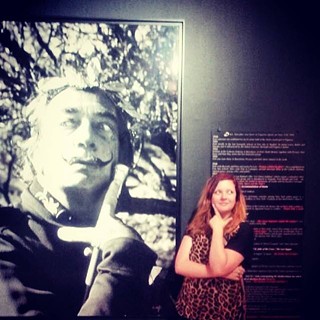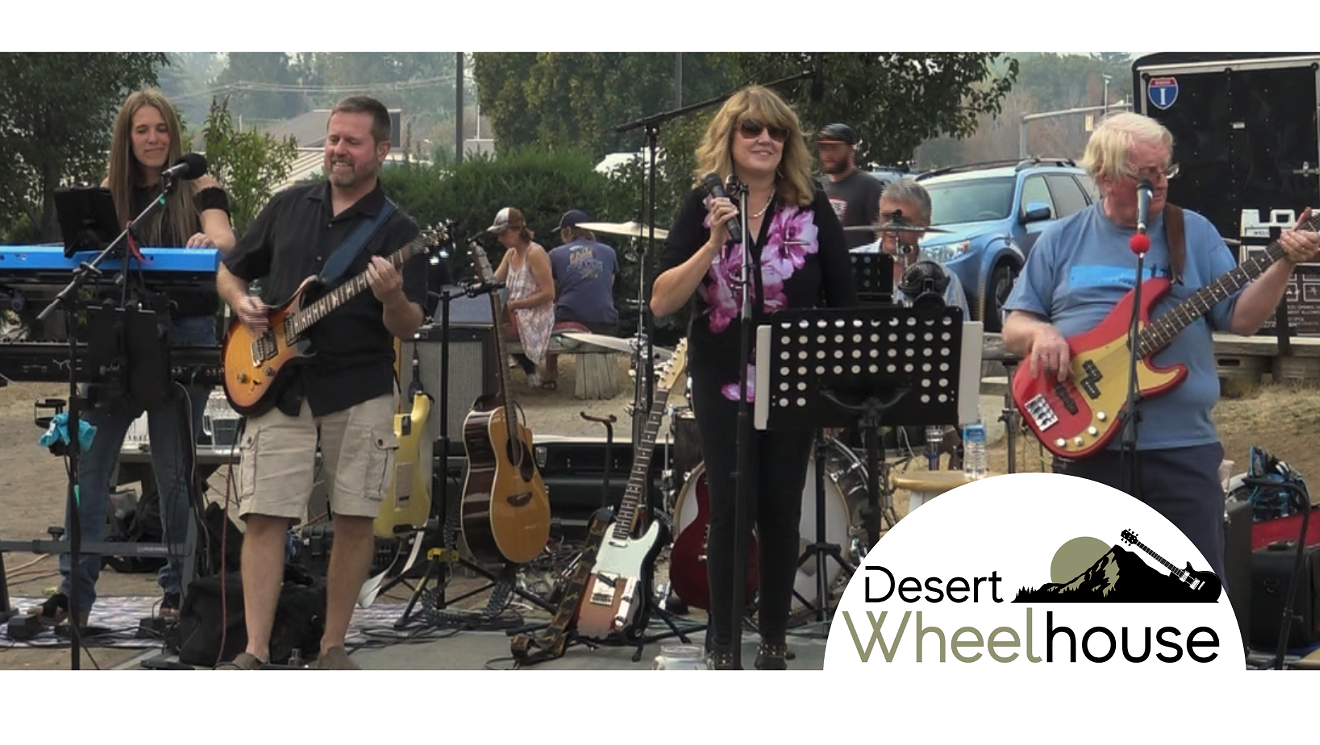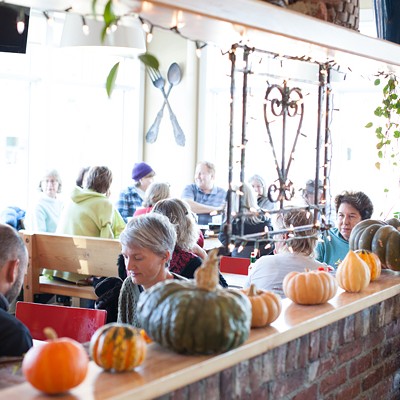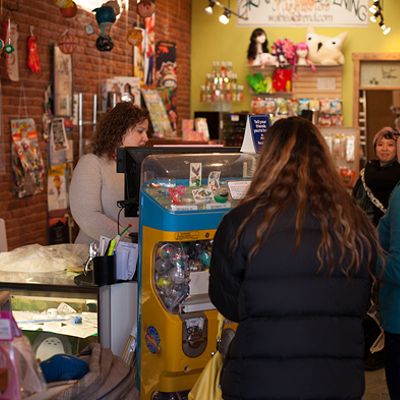At Target, the florescent lights are buzzing over the women's clothing department. It smells like starched polyester; a hint of popcorn wafts in from the nearby snack shop. Racks and racks of jackets, jeans and dresses line up in waves of colors and sizes: tween graphic T-shirts sporting Mickey Mouse silhouettes; bright blue skinny jeans folded in stacks of a dozen; nearly neon maternity dresses. The men's section is the same: plaid shirts with crisp collars, folded under backlit signs announcing "19.99!" An employee in a red polo shirt shuffles through the racks with a cart of returns, she frowns deeply and ignores the nearby shoppers.
I immediately know I'm at a Target, but also realize that it could be any Target. Outside the automatically swinging doors could be any place, Idaho to Iowa.
In another world—outside the walls of this Target and a couple miles south, is Vanilla, a locally-owned clothing store in the Old Mill District. Decorated with brightly colored hats, jackets and racks of shoes, the store has a specifically Bend vibe—the shelves are cluttered with fashionable athletic wear, and did I mention the adorable shoes? Everything feels individualized; just one or two of each item hang from the racks, and the lush fabrics cry out, making me want to touch everything in the store. When I walk through the door I'm greeted by not one, but two smiling and sharply dressed young women; their enthusiasm wraps around me like a tailored jacket.
Big box stores—Target, Macy's, Kohl's and JCPenny—are the go-to for generic clothing gifts during the holidays. In fact, many are opening so early on so-called Black Friday that it isn't even bright yet (4 am Friday morning; and, as if that isn't soon enough, some stores even are staying open this Thanksgiving until 8 pm so that shoppers can end one holiday prematurely to get a jump on the next, more commercial one). Even throughout the recent recession, retail sales on this first big—BIG—weekend of holiday shopping continued to climb, reaching a dizzying $52.4 billion last year, a number
econommists expect to be far surpassed this weekend. The bulk of these sales were at so-called big box stores—warehouse-like buildings that stock pedestrian brands and help shoppers find clothes, appliances, and toys just like their neighbors have and just like those seen on TV.
By comparison, last year, the Institute for Local Self Reliance surveyed thousands of locally owned businesses and found that during the holiday season, sales at independent businesses increased a negligible 0.8 percent from the previous season. Moreover, 80 percent of surveyed local retailers complained they experienced difficulty competing with big businesses, especially because of trends like "showrooming," where customers seek information locally, and then buy products online.
Yes, big box and retail chain stores are convenient and can be less expensive. Looking at two jackets, a basic black peacoat from Target ($69.99) and a similar coat at local retailer Kariella ($128) closer examination shows the latter coat to be carefully detailed and sturdily built. Yet, is that worth nearly twice the price?
"It's hard for people to understand," explained Amara Bessa, owner of Kariella, the small downtown clothing boutique. "Sometimes they come in and they say, 'I'm saving my money to go to Nordstrom's' I always say 'Please don't do that!' [Shopping local] is what fuels the local economy. My business is not possible unless people are participating."
Between price matching, red tag sales, free shipping and bulk ordering, ginormous retailers can afford to do things that small boutique stores just can't. However, spending those few extra dollars can make a big impact on the local economy. Bessa says it makes all the difference for her business.
"It gives us opportunity to give back in other ways by partnering with other business or charities; it's more of an impact than shopping big box," she explains. "It's continuing to grow my inventory to offer bigger selection to the locals here." She also adds that it allows her to pay employees real, living wages (a point underscored by interoffice memos leaked over the past week from Wal-Mart, which instructed its employees to get onto food stamps, and from McDonalds, which provided a manual for low-income living, with suggestions like selling Christmas presents for extra money).
A study conducted by Civic Economics in Salt Lake City found that local retailers return 52 percent of their revenue to the local economy, compared to just 14 percent returned by big box stores. In a similar study conducted by the same organization in Portland, Maine (a city about twice the size of Bend), researchers found that every $100 spent at locally owned businesses contributed an additional $58 to Portland's economy. By comparison, $100 spent at a chain store in Portland yields just $33 in local economic impact. The study concludes that, if residents of the region were to shift 10 percent of their spending from chains to locally owned businesses, it would generate $127 million in additional local economic activity and create 874 new jobs. For example, Kariella has been open for more than 3 years and has grown from just one employee, Bessa, to five part-time employees.
Another, less tangible but equally robust advantage to spending that extra $50 locally is that items tend to be a higher quality and more original, they also contribute to Bessa, and other local business owners' dreams.
"I've wanted to have my own clothing store since I was a little girl," says Bessa. "Starting it wasn't easy it was kind of hard with the economy with the way it was. It was impossible to get any loans so I saved and invested my money and started really small. Over the course of a year I grew it and just continued."
While the price tag continues to rise on these handsome creations, they are often one-of-a-kind pieces that are the product of hours of invested time, trials, failures and the creative effort of the designer, rather than a soulless mass produced garment from a national retailer (or, dare we say, manufactured overseas in some sweatshop). Alicia Renner of Howl Attire—who makes women's and men's clothing, accessories, bags and jewelry—explains how buying from a local artist allows for a very simple production-consumption model.
"You're literally putting money back into the local economy and supporting someone who you can meet and hang out with," says Renner. "Everything is hand made you can come and say hi to me and watch me make stuff; it's all happening right here."
Rather than being assembled on some mysterious assembly line across the world, the creators of local designs are accessible, detailed and fashionable. These types of gifts come with a great story to tell and are a sign that you really thought about what the recipient would like—that's just good gift giving.
Priced at around $400, Renner's gorgeous wool jackets are pieced together from local and natural fibers (leather, fur and wool) and some vintage fabrics. They have a distinctly Pacific Northwest look and are completely one of a kind. Purchasing from her, or any of the other artists at the Old Iron Works is a way to support local arts and give a fantastic gift.
"It supports me; this is my main gig right now so if I can sell things, then I get to live and eat and it's obviously motivational to make a sale," says Renner.
Not only are big ticket items available, on Nov. 30 in the spirit of Small Business Saturday, the Iron Works will be hosting its annual $10 sale with small pieces available on the cheap. Sarah McMurray, another member of the Old Iron Works art studio, says buying from local artists is the only way to get a big or small garment with true soul.
"Shopping locally not only strengthens the economy, but also supports your neighbor, your sister, your best friend, all people who are talented artists and craftspeople," she says. "Yes, big box stores are sometimes cheaper, but when you buy from a local artist, you get more than a product that was mass produced—you get a piece of someone's heart and soul, a creative bit of our very talented community and you can interact with the artist to hear the story behind their craft. It's a beautiful exchange!"





















